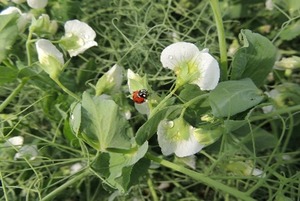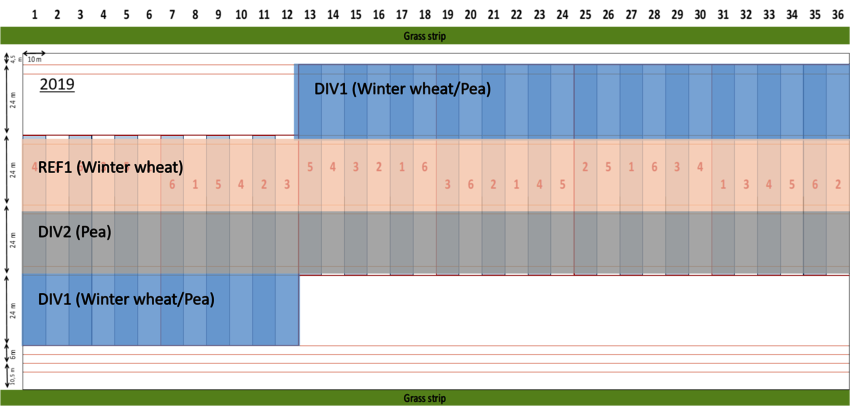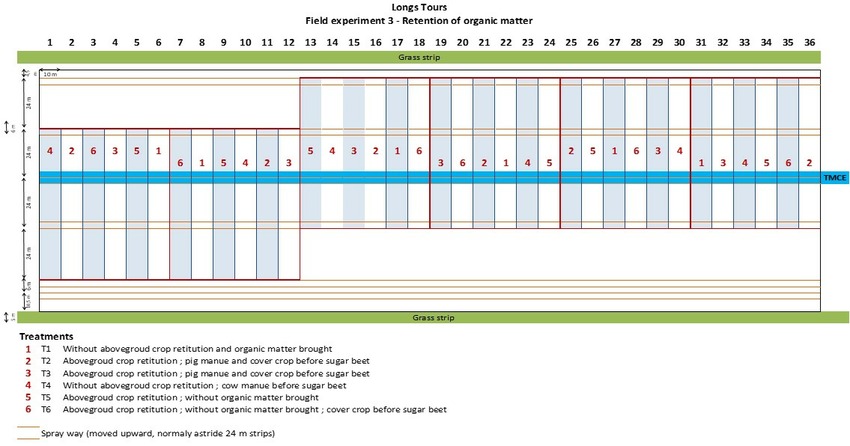Arable cropping systems with different organic matter management strategies and diversified with legume intercropping and service crop
Field experiment 3, Belgium

Trial location and duration
Location: Belgium, Gembloux (50°33′ 54″N, 4° 41′ 18″E, 160 m a.s.l.)
Trial duration: Long term experiment on organic matter management started in 1959. The diversification with legume intercropping was conducted between 2018-2020
Objectives and research question
We hypothesized that changing the organic matter management (crop residue retention versus removal) would modify the diversity and the dynamic of the soil microbial community. The diversification strategies tested are also of interest in terms of reducing nitrogen inputs, limiting pest and disease pressure, increasing organic matter in the soil, and increasing the diversity of cultivated species through multiple cropping and intercropping.
Experimental design
The reference 3-year rotation is based on a first crop such as sugar beet or maize, followed winter wheat and winter barley. Three diversification strategies were implemented: i) addition of service crops (phacelia/clover) before the first crop of the rotation (sugar beet or maize), ii) intercropping of pea with winter wheat, iii) replacing wheat with a pea sole crop in the rotation.
The trial has six replications in a randomized block design with 10x72 m plots (Fig. 2). The long-term experiment has six treatments of organic matter management, but only treatments 1, 2, 4 and 6 were retained and studied within DiverIMPACTS. Table 1 characterises these treatments in term of how crop residue was used, application of external organic matter and use of winter service crop (phacelia/clover).
Within the framework of DiverIMPACTS, diversification based on wheat/pea intercropping (50/50% based on seed weight) was implemented in 2019. Fig. 3 shows the division of the historical trial into three distinct strips: wheat/pea combination, pure wheat and pure pea. The crop rotation is shown in Table 2.


Main findings and highlights
- The protein and lysine (amino acid) content of wheat is higher when cultivated in association with pea
- The soil organic carbon content of the wheat pea intercrop was nearly the same as the pure winter wheat. The nitrogen content of the intercrop is higher than in the reference.
- Soil organic carbon levels did not change after four years
- Weed development is the same with or without intercropping
- Long-term crop residue retention increases and stabilises the abundance of the microbial community
Main challenges
- After three full growing seasons, it is difficult to observe the impact of diversification strategies as effects (success of service crops, pest and diseases pressure, etc.) are either highly dependent on the annual weather condition or evolve slowly (e.g. soil carbon content).
- It is difficult to adapt an existing long-term trial to implement additional strategies, while remaining in line with the system approach, as new management rules are required.


 tap and then scroll down to the Add to Home Screen command.
tap and then scroll down to the Add to Home Screen command.